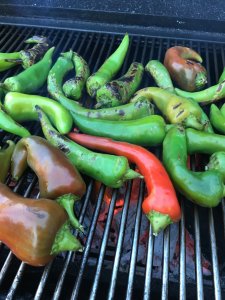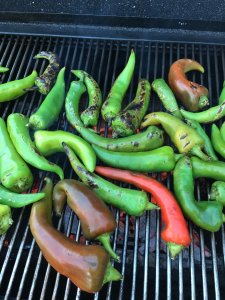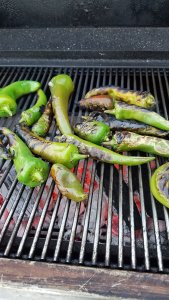Is it Chile or Chili? Here’s the Answer….
Note from Peter: A few months ago I received an e-mail from Steve Marquez, who you will meet below, correcting my spelling of the word “chile,” as in chile pepper (and not as in chili con carne, which was my error). He was right, of course, and I could see he was really passionate and deeply connected to his beloved Colorado and New Mexico chile (and not chiles — it is always chile, even when plural). So I asked him if he’d write a guest column for everyone’s benefit, sharing this sense of connectedness that so perfectly captures the spirit of what Pizza Quest is all about. Here is his column, so, thank you Steve! I’d love to hear from others who share similar passions for any type of food or artisanship and would like to share them as Steve has done. Just write to me at peter@pizzaquest.com. But for now, here’s a great column on the Colorado chile (not chili) pepper:
In the final segment of the Pizzeria Brava della Strada webisode series, we see David Bravdica’s pizza and the influence of locally sourced ingredients including roasted Colorado green chiles. I was excited to see Denver, my adopted hometown featured so prominently on the final segment of this series. But I was compelled to send feedback to Peter Reinhart about the misspelling of ‘chile.’
For most people, it is trivial and a non-issue. But for a chile fanatic like me, it is the start of sharing the passion for this fresh locally sourced ingredient that is true to the North American Southwest from which it originates.
As a kid growing up in New Mexico, my mother would pick me up from elementary school. During the fall, on our way home, we would stop by the neighborhood market to buy green chile. I remember vividly the smells of a green chile being roasted in a huge gas fired rotisserie by the bushel outside of the grocery store, the aromas changing from the fresh green vegetal smell giving way to pungent and smoky.

Fresh chile, about to be roasted.
During the roasting, the roar of the burners and the whining of the electric motor was so loud that I could not hear my mother call me. Mesmerized by the smells, I stepped ever so closer to the huge, dangerous machine until I was pulled back by my mother. Even as a child, I was becoming addicted.
When the operator deemed the roasting to be done, charring the skin of the chile so that it was just about burned to the flesh the burners and the motor were stopped and the chile were deposited into a plastic bag to steam. This part was important, as it would make peeling the chile much easier.
After returning home, my mother would select a few of the chiles, peel them, and then dice them by hand. She then buttered a freshly made flour tortilla and added a scant amount of chile. At that age, if she added too much I would not be able to eat it. And boy was I hungry! She would season it with a bit of diced garlic and salt, roll it up, and hand it to me. The taste was amazing — and unforgettable.

Starting to char.
Now that I am grown, I do not have my chile roasted in the tumbler type of gas fired roasters that I remember from my childhood. To me, these huge gas fired roaster over-cook the flesh of the chile for the sake of charring the skin. Instead, I hand roast my chile over a charcoal grill, flipping them as the skin blisters but remaining intact. In my opinion, in this way, I can separate the skin while the flesh underneath roasts but remains firm. It will acquire a sweetness and complement its pungent heat. Adding to it would be the slight smokiness from the charcoal. After the entire surface is blistered, I transfer the chile to a paper bag sitting inside of a small cooler. This will help retain the heat so that the skin separates cleanly from the flesh.
Anybody can roast green chile in this way. I prefer charcoal, but my wife likes it when I roast them over our gas grill. And of course roasting in a wood fired oven would be a great way as well. The key is to blister the skin evenly by turning the chiles, exposing it evenly to the heat. I like to allow it all to rest afterwards by placing them in a cooler. But when I do just a few peppers, I’ll blister them, transfer them to a ramekin, and then wrap a towel around it to help it retain heat and steam somewhat. After cooling, it’s easy to peel, dice, and season with a bit of kosher salt and garlic.

Now we’re talking!
During the fall, I buy an amount of chile, about the size of a small laundry basket, from one of many local stands scattered around Denver. We’ll buy several, over a few week timeframe, for roasting and freezing in small packages for the upcoming year. I like to roast a half basket at a time, usually after work. It’s a nice way to relax.
My first choice for green chile is the locally grown variety called Mosco originating in Pueblo, Colorado. It differs from the more well known Hatch variety by having a thicker skin, and corresponding thicker flesh. These chiles have great flavor.
In early October we drive to Albuquerque for the Balloon Fiesta, and return back to Colorado with a sack (an amount much larger than a basket) of green chile. We select a variety grown in the Rio Grande Valley, just south of Albuquerque. Sometimes the variety is named, but often it’s not. You’ll see varieties including, but not limited to, “Big Jim,” “Sandia,” and “Espanola.” But to me the most important quality of the chile is where and how it was grown, and how it was treated after harvest. The concept of ‘terroir,” borrowed from vinters, can be applied to chile as well.
I am grateful for being able to stock up on some great chile during the fall, by freezing my green chile, so that I can enjoy it year round. For those times that I planned poorly, and did not build this treasure cache, I would have to buy my chile fresh from the chain grocery store. Those varieties most often seen are the “Anaheim.” They are grown in California, but have a New Mexico origin. Despite its heritage, it suffers like most commercially available produce and lacks the beautiful flavor of local sourced ingredients.
That was the beginning of my enjoyment of chile. I encourage everyone to try pizza with green chile if its available in your area. If that is not possible, try roasting your own green chile and add it to your dishes. Source your ingredients locally and prepare them as fresh as possible. But for the sake of the experience, avoid the canned diced green chiles. It would be like substituting ketchup for San Marzano sauce.
Recent Articles by Peter Reinhart
- “Tommy & Atticus” in Redondo Beach, CA. A Sourdough Success Story
- Howard Brownstein on Turnaround and Crisis Management
- Randy Clemens and Forest Farming in Uruguay — The Back to The Earth Movement is Back!
- It’s not too late to chase your dreams: “Pizza From the Heart” A New Book by Paulie and Mary Ann Gee
- Kyle Ahlgren on the Artisan Baking Center Online Classes (and a special offer)
- Multi-James Beard Nominee Cathy Whims of Portland’s Nostrana and her Brand New Book
Comments
Add Comment
You must be logged in to post a comment.










Steve,
Thanks for your personal history and lesson on chile! Keep us posted with more chile tales anytime!
*If you have a favorite Chile Pizza, send us the recipe to share and I’ll do a post on it.
As someone who makes pizzas in chilly Chile with chiles, I think it is unfortunate that the term “chile” is used in English – here in Chile a chile is an “ají” (plural: ajíes). Anyway, when dried and ground would it be chili powder or chile powder? http://www.szot.cl saludos Kevin
That’s a great question, Kevin and, while I’d say “chile powder” would be logical because it’s made from chile peppers, most Americans I’d wager use “chili powder” because its used to make chili con carne. But what do I know? Let’s throw this out to our readers — does anyone have the answer?
Hi everyone,
Brad, Thanks for the kind words. I’ll put some recipe suggestions for you. Off hand, a very tasty one is quattro formaggi. I use olive oil instead of red sauce. I will send others that work well.
Peter, your comments describe my observations of available ingredients here in Colorado/ New Mexico.
In our local markets, dried chile is available as pods, or ground into a powder. Also available is “chili powder,” a compound which can contain dried chile peppers, cumin, paprika, aromatics and other spices.
Thanks Steve — great info!!